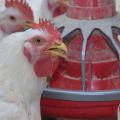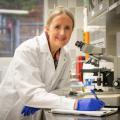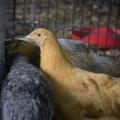Construction of a still-air incubator
Small incubators, suitable for use in the home, can be purchased from stores that sell farm equipment. An egg incubator can be built at home with a little work and expense.
The first incubator is constructed from a polystyrene ice chest. It is inexpensive, and because it is insulated, is inexpensive to operate. It can be damaged easily. The eggs and chicks can be observed through a window in the lid. This incubator will hold about 40-45 eggs.
The second incubator is more expensive, but is more permanent. It is constructed of plywood and glass, and will accommodate up to 100 large eggs. Both incubators are heated by a commercially available heating cable. The heating cable can be replaced with two or three ordinary light bulbs. Get a list of organizations that sell incubator supplies and equipment from your county agent or state poultryman.
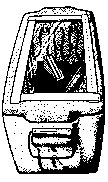 Polystyrene Incubator
Polystyrene Incubator
You'll need the following equipment and supplies to construct this incubator.
- Polystyrene ice chest (12-16" x 20-24" x 12"-15")
- Heating cable
- Micro-switch assembly (thermostat)
- Glass (approx. 10"x14")
- welded wire - hardware cloth (24"x36")
- Cake tin (9"x14"x1 1/2")
- Thermometer
- Masking tape
Get all equipment and supplies before starting construction. Carefully read and understand the instructions. Expect to spend about 2 hours building the incubator and 4 hours testing it. A description of the construction process, complete with illustrations, is available online.
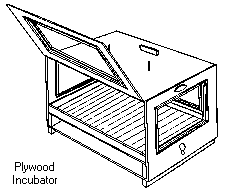 Plywood Display Incubator
Plywood Display Incubator
This incubator is more expensive and will take longer to construct than the polystyrene incubator, but it is more durable. It is built of ½-inch exterior or marine grade plywood and glass, and will accommodate up to 100 large chicken eggs. Building plans for this incubator are available online.
Bill of materials:
| 1 pc 5 pcs 1 pc 1 pc 1 pc 1 pc 1 pc |
1/2"x4'x6' A-C Exterior Plywood 3/8"x3/4"x8' Pine 3/4"x1½"x13' Pine 3/4"x3¼"x4' Pine 1/2"x3/4"x8' Pine 1/2"x18"x27" rigid insulation board 18"x27" heavy duty aluminum foil |
| 1 pc 4 pcs 4 pcs 2 2 2 1 pc |
1/2"x30" semi-rigid plastic pipe 10"x20" single strength window glass 10"x14" single strength window glass 1½" roundwooden drawer pulls metal drawer pulls (cup type) 2" hooks with eyes 8' felt weatherstripping 1/4"x1/2" |
| 1 pc 2 1 1 2' |
20"x27" - ¼" hardware cloth vent covers - sheet metal incubator electrification kit * attachment plug No. 18-2 flexible service cord |
| 1 10 1 pr 1 1 pc 1 pc |
duplex outlet for surface mounting small porcelain knobs for heating element 4"x1" flat hinges water pan - minimum 360 sq. in. 1/8"x16½' steel rod 3/16"x8' steel rod Assorted nails and screws Waterproof wood glue |
Both incubators are heated by a commercially available glass-covered heating element. For the plywood incubator, it should provide 160 watts of heat. Slightly less heat is required in the polystyrene incubator.
Publications
News
STARKVILLE, Miss. -- Until an avian flu vaccine for chickens or other alternative is federally approved, commercial poultry operations in the U.S.
STARKVILLE, Miss. -- If egg prices have seemed higher than ever lately, it’s because they are, and consumers can place much of the blame squarely at the feet of the ongoing bird flu outbreak.
With highly pathogenic avian influenza, or HPAI, in the environment in Mississippi, owners of backyard flocks have to take extra steps to keep their chickens healthy.
Avian influenza poses an extremely low risk to human health and none to food safety in Mississippi, but its presence poses a risk to backyard flocks and the state’s $3 billion commercial poultry industry.


